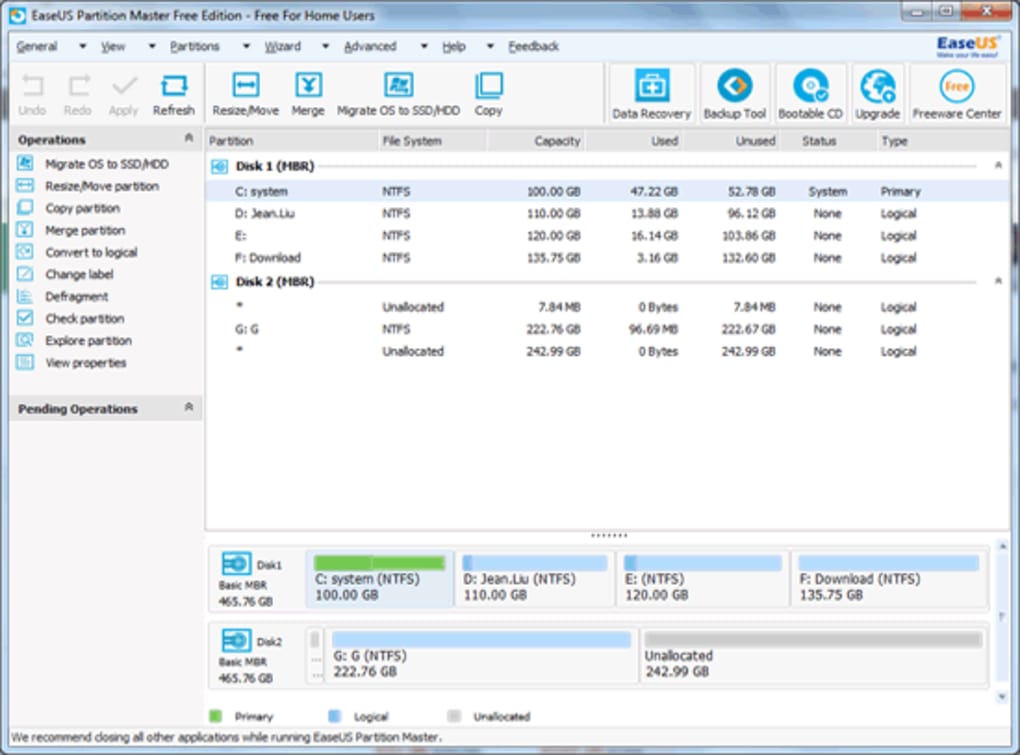

- #EASEUS PARTITION MASTER PROFESSIONAL WINDOWS 7 DRIVER#
- #EASEUS PARTITION MASTER PROFESSIONAL WINDOWS 7 FULL#
Two things *always* ring true: no one ever thinks of everything, & the best advice or suggestion is the one that works, regardless where it came from.
#EASEUS PARTITION MASTER PROFESSIONAL WINDOWS 7 FULL#
I've run shops full of master techs with decades of experience. That doesn't make me smart or dumb - experienced or not - just plain old. I've been at this a loooong time - I learned Basic using a teletype connected to a mainframe, used to read/write keypunch & so on. with no real technical background or training."

/easeus-partition-master-free-edition-1be1fd7437414ca8bc17dd2985236cab.png)
Other than that I commend the developers for offering updates as and when they become available as do others as can be seen by the steadily rising ratings of the new versions each timne they are released here on GAOTD and I look forward to the next version apearing here, hoping at least some of my wish list makes it in. These are the sorts of things I would expect in a Partition Master Professional program. But the program doesn't even see the mass storage device! I would like to see it be able to create ext2/3 partitions too with user defined block sizes for all the formatting it does, depending on what we plan to store on a drive it makes sense to define the appropriate cluster size from 0.5K right up to 64K for optimum performance rather than sticking with the default which is a compromise between speed and slack space wastage for mixed use.
#EASEUS PARTITION MASTER PROFESSIONAL WINDOWS 7 DRIVER#
It also doesn't understand ext2/3 partitions even though an installable file system driver is present and active and drive letters are allocated, it incorrectly calls the partitions "Other" It also fails to even see my 16G SD flash card that alreadt has been converted into a basic MBR disk and partitioned. But is also used as backup device for my DVB-T/R ext2 based filesystem too. It is primarily used on my HD sat receiver as an external drive for it DVR function. I have some issues with this Partition "Master" Pro, it fails to even see my FAT32 partition even when windows has allocated it a drive letter it's clearly partition type 0x which is 0C FAT32-LBA, the only unusual things about the partition are it is on drive letter A: since floppy drive letters are never used here and it is allocated to an entire 1T.0 external drive. NTFS and ext2/3 offer much smaller cluster sizes, with NTFS defaulting to 4Kbyte if I recall correctly. Other error is regarding cluster size, what you say is only true of FAT-32 formatted drives. Not to mention the lower power consumption and quieter operation. And the rest of the 1T.0 drive can be partitioned for archival purposes. I have seen one article pointing out that nowadays it is cheaper and in many ways better to get a 1T.0 7200rpm SATA than 300Gig 10000rpm drive since the first 300G of the 1T.0 drive will average out at much the same if not better performance than the average performance of the more expensive 300G suposedly faster drive. test it yourself with any UDMA (don't test it on a USB connected drive) capable disk erasing program that reports the realtime write speed and you will see during the first 10% or so of the drives erase cycle the write speed is quite impressive with modern drives managing a large percentage of the interface speed capability but as the write progress it gets progressivley slower, almost painfully slow compared to the first 10%. For these reasons alone, for maximum drive performance the OS, regardless of type should be placed in the first partition aproximatly 10% the size of the presumably large drive and the paging file moved to the outer edge of the partition with a decent disk managment tool, especially in vista which make heavy use of the paging file regardless of how much RAM you give it. The reason is twofold, one there are more sectors in the outer tracks yet each entire track is read or written in the same amount of time as the tracks nearer the center and two since more sectors exist per track in the outer tracks less mechanical seeking has to take place. #21, You have a couple of factual errors in your statements, it is a fact that all magnetic drives that have a constant RPM will perfom significantly faster at the outside tracks.


 0 kommentar(er)
0 kommentar(er)
